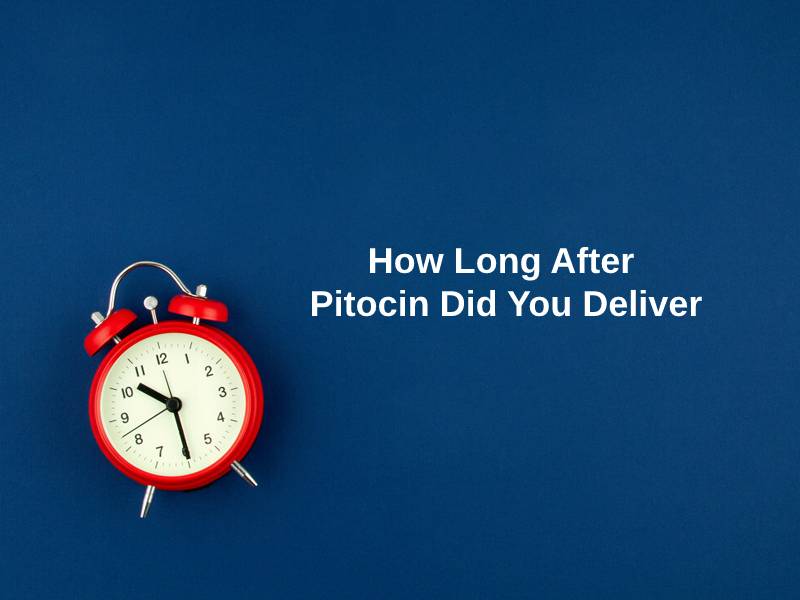Exact Answer: 6 to 12 hours
Oftentimes, when labor does not start on its own, the process requires a little artificial push. This is achieved by the use of synthetic drugs like Pitocin. Pitocin is a well-known hormonal medicine that is administered to pregnant women to induce labor.
The labor hormone- medically known as Oxytocin- is the main component of the synthetic Pitocin drug. When the pregnant woman is administered the drug, its hormonal formula initiates uterine contractions that in turn, helps induce labor. Generally, doctors opt for Pitocin as an artificial inducer when the pregnancy has already crossed its due date or when the patient may want to accelerate the delivery process.

How Long After Pitocin Did You Deliver?
Usually, the time taken by the hormonal formula in Pitocin to start working varies between 6 to 12 hours. However, it is important to cognize that this is an average range, based on the most common outcomes that were noted in hospitals using Pitocin to induce labor.
Within the first 30 minutes of the drug being administered intravenously in the mother’s body, a chemical process ensues. The first contractions begin soon after as a consequence of this reaction. However, moving into active labor takes a significantly longer period of time.
Women will slight cervical dilation delivered their babies within merely 4 hours of Pitocin being administered to them, while those without any cervical dilation delivered their babies after a strenuous period of 12 hours or more. Similarly, there have also been cases where after the initial contractions, a woman has been unable to deliver the baby, even when induced with the drug. In such rare instances, she is sent back home and the entire process is retried from the beginning on another day.
However, a key element in the entire process of induction is to keep the patient under constant observation throughout the day. The medical staff checks on the mother’s effacement levels and dilation measurements throughout the day when Pitocin is administered to them.
Predicting the time taken by Pitocin to actually induce labor is an essentially difficult endeavor. The effects of the drug vary from one individual to another. Thus, there exists no foolproof way of determining a definitively exhaustive timeline for the delivery after the drug has been administered to the pregnant mother.

In summary:
| Conditions When Pitocin is Administered | Time Taken to Deliver after Pitocin |
| With a slightly dilated cervix | 6 hours |
| Without a dilated cervix | 12 hours |
Why Does It Take So Long To Deliver After Pitocin?
Pitocin works by inducing uterine contractions. When the drug is administered, its hormonal concoction helps stimulate the uterine muscles that in turn helps to dilate the cervix for delivery. The baby cannot be delivered until the cervix is fully dilated.
The rate at which Pitocin will help accelerate uterine contractions will be hinged on the dosage of the drug prescribed by the physician in charge of the patient. The goal is to reach a dilation of at least 8cm before the delivery can be started.
After the drug is administered, it takes time to increase the cervical dilation as well as effacement. Usually, active labor will not begin until the patient reaches close to a 100% effacement or ripening of the cervix. This implies that the cervix is fully prepared for delivery.
This number of effacement is known as the ‘Bishop Score’. After administering Pitocin, it will take time to increase the score and cervical dilation, according to the dosage of the drug prescribed. The uterine contractions initiated by the drug will help in increasing both these variables. However, this is a lengthy process.

Thus, the prior cervical dilation of the patient can be handy in accelerating the process after Pitocin is administered. Women who are 3cms to 4cms dilated and favorably effaced before Pitocin have a better chance of an accelerated delivery after the drug is administered than those who are not effaced or dilated. However, much like normal labor, the entire process cannot be definitively encapsulated within a given time frame. Each body reacts differently to the drug, which in turn has a bearing on its efficacy.
Conclusion
Pitocin is considered to be a wonder drug among many healthcare professionals as it helps accelerate the grueling labor process. However, there are certain safety concerns with regard to its use including risks posed both to the mother and child as a consequence of the intense contractions that result from the drug.
However, it is widely used to increase the Bishop Score of the pregnant mother and help hasten the delivery process. Usually, if the mother is slightly effaced and dilated, Pitocin will help deliver the child within 4 to 6 hours. However, if she is not dilated before the drug, the delivery process may take much longer. This can sometimes also exceed the 12-hour limit.